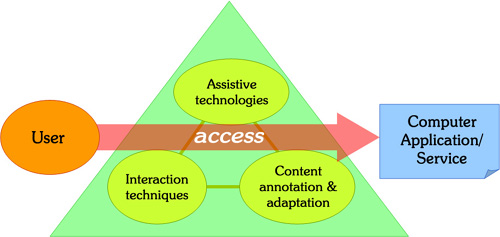| Computer Accessibility | People with disabilities | Disabilities affecting computer accessibility | Computer Accessibility Strategies | Design for All and Universal Access |
Computer Accessibility Strategies

Disability-related accessibility problems are usually tackled through a combination of:
- assistive technologies, i.e., devices that are suitable for, or compensate to some extent for a specific disability;
- interaction techniques, that on the one hand are appropriate for the disabled person's interaction capabilities and needs and, on the other hand, can work with, and take advantage of, any available assistive technologies;
- content annotation and adaptation, so that it can be rendered in a format that can be optimally perceived and used through the employed assistive technologies and interaction techniques.
The basic strategies for making computers accessible by each impairment category include:
- Visual impairments
- Content annotation with semantic information.
- Provision of the content through alternative modalities, such as audio and tactile (in the form of Braille).
- Support for content enlargement, e.g., control of font size, zooming facilities.
- Customization of color combinations to improve contrast and simplification of visual complexity (e.g., replacing background images with solid colours) to improve legibility.
- Support of input through the keyboard, Braille devices and speech.
- Ability to serially and hierarchically browse the content and interaction objects in a logical order.
- Motor or dexterity impairments
- Support / provision of alternative input devices and techniques, such as switches, specialized keyboards, mice, trackballs and joysticks, scanning, visual keyboards and speech.
- Speed and timing control and adjustment to suit different response times.
- Ability to serially and hierarchically browse the content and interaction objects in a logical order.
- Hearing disabilities: they may range from total deafness (i.e., the person is not able to hear at all), to slight loss of hearing (the person can sense sounds and speech, but finds it hard to identify their content).
- Visual representations of auditory information.
- Augmentation of speech with sign language.
- Cognitive disabilities
This is probably the hardest category since sometimes, depending on the type and level of disability, solutions must be provided at an individual basis. In general, all related solutions include:- Provision of alternative (simplified, illustrated) versions of the content.
- Simplification of tasks, e.g., through step by step procedures and wizards.
- Avoidance of blinking and flashing at particular rates that can cause photosensitive epileptic seizures in susceptible individuals.
- Speech impairments
- Support of alternative input / communication methods when speech is required.
- Illeteracy
- Content simplification.
- Provision of textual content through illustrations, audio and video.
It should be noted that each impairment has different severity levels, possibly requiring different solutions, and that sometimes people have combinations of disabilities, thus raising compatibility issues between individual approaches.






